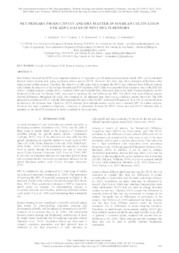Net primary productivity and dry matter in soybean cultivation utilizing datas of ndvi multi-sensors.
Net primary productivity and dry matter in soybean cultivation utilizing datas of ndvi multi-sensors.
Author(s): RODIGHERI, G.; FONTANA, D. C.; SCHAPARINI, L. P.; DALMAGO, G. A.; SCHIRMBECK, J.
Summary: Net Primary Productivity (NPP) is an important indicator of vegetation growth status and ecosystems health. NPP can be estimated through remote sensing data, using vegetation indices such as NDVI. However, this index may show systematic differences when using several orbital sensors. Therefore, the objective of this paper was to compare the NDVI data obtained from different sensors and evaluate the impact over the soybean biomass and NPP estimates. NDVI data were recorded from 4 sensors, one on the field and others 3 orbitals sensors (Landsat 8/OLI, Sentinel 2/MSI and Terra/MODIS). Measured data on the field, Photosynthetically Active Radiation (PAR) and Dry Matter (DM), were used to modeling the total DM and also NPP. The NDVI data from different sensors showed differences throughout the cycle, but compared to the reference data there was a correlation greater than 0.84. The DM presented a correlation of 0.91 with the field measured MS data while the NPP presented differences of up to 240 gC/m²/month from in relation to the reference data. Therefore, NDVI obtained from multiple sensors can be used to estimate NPP for surface analysis. However, for more consistent evaluations, a function of adjustment between the NDVI sensor data and NDVI reference data is required, so that the NPP estimation be better correlated to the actual data.
Publication year: 2020
Types of publication: Paper in annals and proceedings
Unit: Embrapa Wheat
Keywords: Agriculture, Google Earth Engine, PAR, Remote sensing
Observation
Some of Embrapa's publications are published as ePub files. To read them, use or download one of the following free software options to your computer or mobile device. Android: Google Play Books; IOS: iBooks; Windows and Linux: Calibre.
Access other publications
Access the Agricultural Research Database (BDPA) to consult Embrapa's full library collection and records.
Visit Embrapa Bookstore to purchase books and other publications sold by Embrapa.

